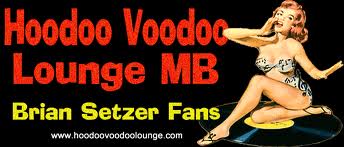
Normally I would put this technical guitar related thread down in the dank, stank, Cave but since I stumbled on an unknown little disc excerpt finding Brian doing isolated tracks on a Royer Ribbon Mic demo CD (pro audio studio recording industry microphones) of Brian, I thought I'd share this gems info up here. (it may also sound like an advertisement, so... ya.. I love em)
We guitarists are always trying to "dial in" the sound of a favorite guitarist that we hear on a recording but the one thing overlooked is that as much as an engineer and the artist try to capture the "Real" sound, things still get tonally colored by the devices used to capture and normalize the sound for a CD/album.
Some engineers work hard to get as transparent as possible and tend to use real "Sterile" equipment, but since Setzer is a vintage Cat he likes to capture his sound the way "it use to be" but unlike many rockabilly or throwback artists, he of course blends the real old vintage with newer things and in my opinion has inadvertantly created his own unique thing in his art and style. This of course is his genius way of driving us
guitarists crazy as we dont have his fretboard prowess so we try to emulate his tone
and style with the "right" equipment.. yet we miss all the gear involved beyond the
guitar rig.
This thread of course is to be focused on how he achieves certain tone palettes in the studio and specifically how he chooses to capture his unique mix of a vintage 60's fender blonde bassman amp that uses modern speakers in its cab and a late 70's tape echo along with his neo vintage Gretsch Nashville hollowbody guitar for rock n roll/ pop.
In the recording "honeyman" he used producers Dave Darling, John Holbrook.
and the guitar n vocals were recorded at Flower Studios. MN.
He used 2 rigs to get his sounds on the song, the first for his solo part and the second
for the rhythm "thump":
1.solo tract: G6120 gretsch into a Supro Amp utilizing the ROYER RIBBON R-121 mic, 8" back and
centered on the speaker, and a SHURE SM-57 MIC positioned off axis on the grill 2" from
the speake cone center.
These Mic's then ran into a NEVE 1066 mic preamp (additionally the SM57 fed into a Universal Audio 1176 compressor after the mic pre)
2. rhythm track: G6120 gretsch into a 59' bassman, 1 ROYER RIBBON R-121 mic
2 1/2 ft. in front of the amp. Mic then fed into a Neve 1066 preamp
(sidenote: drum overheads were 2 ROYER RIBBON R-122 into martec mic preamps, all
recorded digitally with PRO TOOLS EXL. The band recorded at Capital records in L.A.)
You can watch Setzer's ROYER RIBBON mics in action on his guitar cabs during the live
recording of the XMAS 2004 DVD ( i wondered why his tone that night was sooo articulate)
For the lay man, Ribbon Mics in general were the way audio recordings use to be captured along with large diaphram TUBE condenser mics ( ala Neumann ,telefunken,RCA,AKG)... they are enjoying a resurgence thanks in part to the good folks
at ROYER. They have one of the Best and some day I will have this Mic for my own
little studio gear.
John Holbrook said this of the mic
"I love my Royers!! The R121 may well be the ultimate electric guitar mic! I've been using the Royers extensively on recent projects (David Mead, Verve Pipe, Brian Setzer), also the Stereo model for overheads on Bernie Dresel (drummer with Setzer). Thanks for a great recording tool!
-John Holbrook
(The Brian Setzer Orchestra, Verve Pipe, LeAnn Rimes)BTW.. all this information can also be found along with one of the audio tracks:
http://www.royerlabs.com/insidethemix.htmlps. to be fair to "other" ribbon mic makers.. AEA make great mics (GF of the Casino used
one on his Xmas CD too)
You can read about Setzer recording the band with one of these baby's as well as other gems here:
http://www.royerlabs.com/insidethemix.html